Banks’ investment portfolio: RBI pitches for new classification, valuation norms
🔴 As per the proposed norms, the investment portfolio of banks will be divided into three categories — held-to-maturity (HTM), available for sale (AFS), and fair value through profit and loss account (FVTPL).
 The Reserve Bank has invited comments on the discussion paper from stakeholders by February 15. (Reuters/File)
The Reserve Bank has invited comments on the discussion paper from stakeholders by February 15. (Reuters/File)Aiming to align the investment portfolio of banks with the global prudential framework and accounting standards, the Reserve Bank of India (RBI) on Friday proposed new norms for their classification and valuation.
According to a discussion paper by the central bank, ‘Review of Prudential Norms for Classification, Valuation and Operations of Investment Portfolio of Commercial Banks’, the new bank portfolio classification norms will come into effect from April 1, 2023. It has invited comments on the paper from stakeholders by February 15.
As per the proposed norms, the investment portfolio of banks will be divided into three categories — held-to-maturity (HTM), available for sale (AFS), and fair value through profit and loss account (FVTPL). Within FVTPL, held-for-trading (HFT) shall be a sub-category aligned with the specifications of ‘Trading Book’ as per the Basel-III framework.
The new norms propose to bridge the gap between the existing guidelines and global standards and practices with regards to classification, valuation and operations of the investment portfolio of commercial banks.
The extant instructions pertaining to the prudential norms on the classification and valuation of the investment portfolio are largely based on the Report of Informal Group on Valuation of Banks’ Investment Portfolio, which was submitted in 1999.
The recommendations of this informal group culminated in the issue of prudential guidelines on the investment portfolio in October 2002, which forms the basis of the current norms.
While the RBI has been tweaking the guidelines in response to situations as they emerge, a comprehensive review has not been undertaken so far, resulting in a wide gap between the country’s norms and the global standards and practices, the regulator said.
It is against this backdrop that a discussion paper reviews the rationale and the evolution of the current framework, the corresponding global standards, and developments in the financial markets before framing its proposals. WITH PTI



- 01
- 02
- 03
- 04
- 05




























